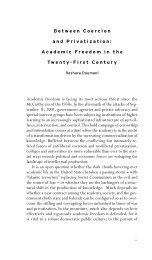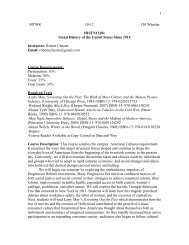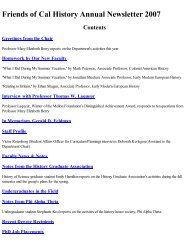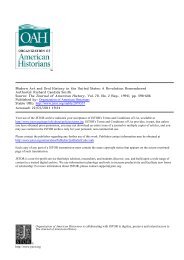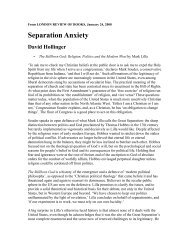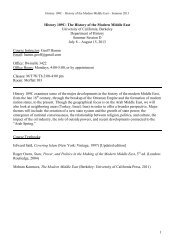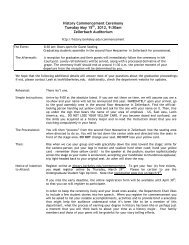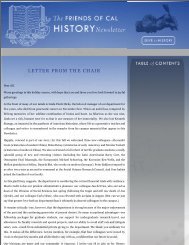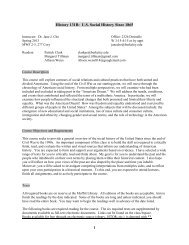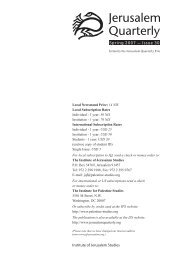David A. Hollinger | Amalgamation and Hypodescent: The Question ...
David A. Hollinger | Amalgamation and Hypodescent: The Question ...
David A. Hollinger | Amalgamation and Hypodescent: The Question ...
You also want an ePaper? Increase the reach of your titles
YUMPU automatically turns print PDFs into web optimized ePapers that Google loves.
ethnoracial mixture behaviorally by exemplifying the relative ease of mixture even for a non-Europeangroup against which miscegenation laws were once on the books <strong>and</strong> members of which were throwninto concentration camps without a shred of due process even within my own lifetime. 44<strong>The</strong> expansion through immigration of the Hispanic or Latino descent community, too, speaks 27behaviorally to the question of ethnoracial mixture in a highly different context, yet in terms thateventually proved almost as challenging to the habit of taking the African-American case as a model forunderst<strong>and</strong>ing <strong>and</strong> responding to the injustices done to other ethnoracially defined minorities. Part ofwhat it meant to be Latino to begin with constituted a challenge to the American system ofclassification, because the category was less strictly color-marked. Immigrants from Mexico, by far thelargest Latin American producer of immigrants to the United States, were understood to derive fromtwo descent communities classified as races in the United States: Caucasian <strong>and</strong> Indian. <strong>The</strong> mixing ofSpanish colonials from Europe with the indigenous population of the New World generated the notionof mestizo. <strong>The</strong> more Mexican Americans in the United States, as Gary Nash has observed, the lessrelevant were the old "racial" categories. 45This mixing of European <strong>and</strong> indigenous blood did not prevent the Latino population of the 28Southwest from being abused by Anglos, who found the Latinos different enough whatever they weremade of. Segregated schools were common in the 1920s <strong>and</strong> 1930s in Texas, California, <strong>and</strong> Arizona.Texas citizens of Mexican descent were routinely prevented from serving on juries until 1954, when theU.S. Supreme Court ruled, in Hern<strong>and</strong>ez v. Texas, that the Fourteenth Amendment rights of Hispanics,even though said to be "white" by the state of Texas, were violated when Hispanics were excluded as a"class" from service on juries. Yet none of the miscegenation statutes mention Latinos by any of thenames they might have been called. Latinos were usually regarded as legally white even when beingstigmatized <strong>and</strong> mistreated. In court cases under miscegenation law, persons said by opposing counsel tobe Negro, as Peggy Pascoe has shown, often insisted that they were actually Mexican. Much thendepended on a court's assessment of the "pedigree," as it was often put, of a person whose marriage wasunder threat of annulment on the grounds of the alleged discovery of a partly black ancestry. 46<strong>The</strong> underst<strong>and</strong>ing that to be Mexican was to be legally white was so taken for granted in some 29settings that the plaintiff in the California suit that resulted in the invalidating of that state'smiscegenation statute was herself a Mexican American. Andrea Perez, both of whose parents had beenborn in Mexico, sued several Los Angeles County clerks for declining to issue a marriage licenseenabling her to marry a man who was black, whom she met on the assembly line in her capacity as a"Rosie the Riveter." (See Figure 2.) Right in the heart of the history of our question, then, in thepathbreaking case on which Loving v. Virginia was modeled, Latinos were sufficiently Caucasian thatPerez's Mexican ancestry was not even mentioned in the case's documents <strong>and</strong> was rarely noted innewspapers other than those published by <strong>and</strong> for African Americans. 47 Perez v. Sharp is a reminder ofhow different California was from the states of the former Confederacy: its state supreme court actuallythrew out a miscegenation statute, <strong>and</strong> it did so a full decade before the Lovings were arrested <strong>and</strong>Hannah Arendt shocked New York liberals with her interest in the issue. 48 <strong>The</strong> situation was somewhatdifferent in Texas, where Andrea Perez might well have been allowed to marry a black man. Mexicans"were rarely, if ever prosecuted" when they married blacks, as Neil Foley has explained, becauseMexicans, while legally white, were "often regarded as non-white." Yet many "middle class TexasMexicans," Foley summarizes, were eventually able to move "out of the ethnoracial borderl<strong>and</strong>sbetween blackness <strong>and</strong> whiteness by constructing identities as Americans <strong>and</strong> embracing whiteness"because they, unlike African Americans, were not "racially marked as black" by "the so-called onedroprule." 49



